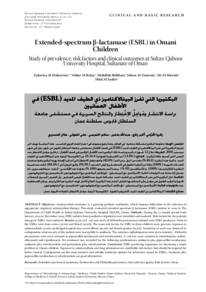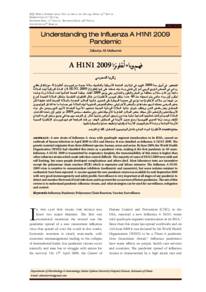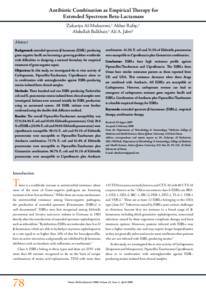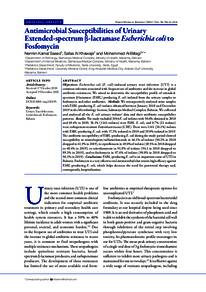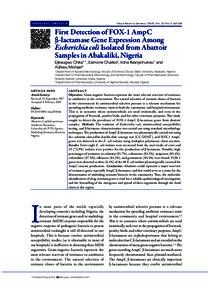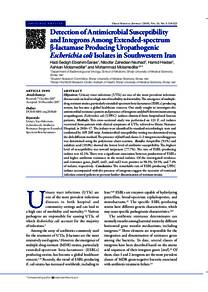Document
Extended-spectrum β-lactamase (ESBL) in Omani children : study of prevalence, risk factors and clinical outcomes at Sultan Qaboos University Hospital, Sultan.
Contributors
Rafay, Akbar M., Author
Balkhair, Abdullah., Author
Al-Tamemi, Salem., Author
Al-Mawali, Ali., Author
Al-Sadiri, Hilal., Author
Other titles
البكتيريا التي تفرز البيتالاكتاميز ذي الطيف المديد (ESBL (في الأطفال العمانيين
Publisher
College of Medicine, Sultan Qaboos University.
Gregorian
2008-07
Language
English
English abstract
Objectives: Antimicrobial resistance is a growing problem worldwide, which imposes difficulties in the selection of appropriate empirical antimicrobial therapy. This study evaluated extended-spectrum β-lactamase (ESBL) isolates in 2005 in The Department of Child Health at Sultan Qaboos University Hospital (SQUH), Oman. Methods: During the 12 month period from January 2005 to December 2005, ESBL isolates from paediatrics inpatients were identified and analysed. Risk factors for the patients who grew ESBLs were analysed . Results: 13.3% of E. coli and 16.6% of Klebsiella pneumoniae isolated were ESBL producers. Most of the ESBLs were from urine (46.2%) and blood (42.6%). The main risk factors for ESBL in these children were previous exposure to antimicrobials (100%), prolonged hospital stay, severe illness (92.3%) and female gender (84.6%). Sensitivity of 100% was observed to carbapenems whereas 92% of the isolates were susceptible to amikacin. The oximino-cephalosporins were 100% resistant. Klebsiella pneumoniae were 100% resistant to piperacillin-tazobactam and nitrofurantoin. E. coli was 100% resistant to trimethoprim-sulfamethoxazole and ciprofloxacin. No resistance was recorded for the following combinations: amikacin plus piperacillin-tazobactam, amikacin plus nitrofurantoin and gentamicin plus nitrofurantoin. Conclusion: ESBL-producing organisms are becoming a major problem in Omani children. Exposure to antimicrobials and long admissions are modifiable risk factors that should be targeted for better control. Carbapenems are the most sensitive and reliable treatment options for infections caused by ESBLs. Amikacin plus piperacillin-tazobactam or nitrofurantoin are good alternatives.
Member of
Resource URL
Arabic abstract
الأهداف: تعتبر مقاومة مضادات الميكروبات مشكلة متنامية في جميع أنحاء العالم ، مما يفرض صعوبات في اختيار العلاج التجريبي المناسب بمضادات الميكروبات. قيمت هذه الدراسة عزلات بيتا لاكتاماز (ESBL) واسعة الطيف في عام 2005 في قسم صحة الطفل في مستشفى جامعة السلطان قابوس (SQUH) ، عمان. الطريقة: خلال فترة 12 شهرًا من يناير 2005 إلى ديسمبر 2005 ، تم تحديد وتحليل عزلات ESBL من مرضى الأطفال الداخليين. تم تحليل عوامل الخطر للمرضى الذين نما ESBLs. النتائج: 13.3٪ من بكتيريا E. coli و 16.6٪ من Klebsiella pneumoniae كانت منتجة لـ ESBL. كانت معظم ESBLs من البول (46.2٪) والدم (42.6٪). كانت عوامل الخطر الرئيسية لـ ESBL لدى هؤلاء الأطفال هي التعرض السابق لمضادات الميكروبات (100٪) ، والإقامة المطولة في المستشفى ، والمرض الشديد (92.3٪) والجنس الأنثوي (84.6٪). لوحظ حساسية 100٪ للكاربابينيمات بينما 92٪ من العزلات كانت حساسة للأميكاسين. كانت مركبات الأوكسيمينو-السيفالوسبورين مقاومة بنسبة 100٪. كانت Klebsiella pneumoniae مقاومة بنسبة 100٪ للبيبراسيلين-تازوباكتام والنيتروفورانتوين. كانت الإشريكية القولونية مقاومة بنسبة 100٪ لميثوبريم - سلفاميثوكسازول وسيبروفلوكساسين. لم تسجل مقاومة للتركيبات التالية: أميكاسين بالإضافة إلى بيبيراسيلين-تازوباكتام ، أميكاسين بالإضافة إلى نتروفورانتوين وجنتاميسين بالإضافة إلى نتروفورانتوين. الخلاصة: أصبحت الكائنات الحية المنتجة للـ ESBL مشكلة رئيسية لدى الأطفال العمانيين. يعد التعرض لمضادات الميكروبات والقبول لفترات طويلة من عوامل الخطر القابلة للتعديل التي ينبغي استهدافها للتحكم بشكل أفضل. الكاربابينيمات هي أكثر خيارات العلاج حساسية وموثوقية للعدوى التي تسببها ESBLs. يعتبر أميكاسين بالإضافة إلى بيبيراسيلين-تازوباكتام أو نتروفورانتوين بدائل جيدة.
Category
Journal articles

